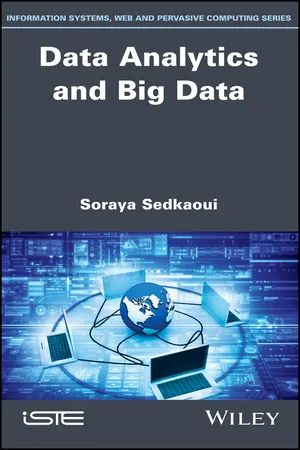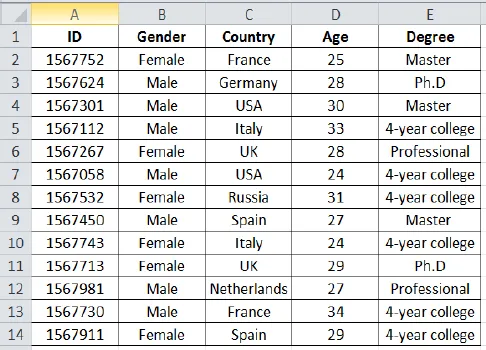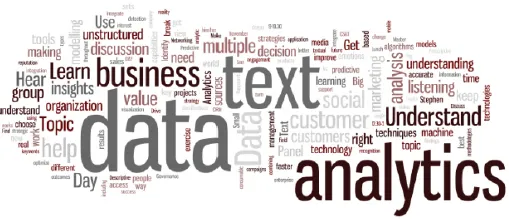
- English
- ePUB (mobile friendly)
- Available on iOS & Android
eBook - ePub
Data Analytics and Big Data
About this book
The main purpose of this book is to investigate, explore and describe approaches and methods to facilitate data understanding through analytics solutions based on its principles, concepts and applications. But analyzing data is also about involving the use of software. For this, and in order to cover some aspect of data analytics, this book uses software (Excel, SPSS, Python, etc) which can help readers to better understand the analytics process in simple terms and supporting useful methods in its application.
Frequently asked questions
Yes, you can cancel anytime from the Subscription tab in your account settings on the Perlego website. Your subscription will stay active until the end of your current billing period. Learn how to cancel your subscription.
At the moment all of our mobile-responsive ePub books are available to download via the app. Most of our PDFs are also available to download and we're working on making the final remaining ones downloadable now. Learn more here.
Perlego offers two plans: Essential and Complete
- Essential is ideal for learners and professionals who enjoy exploring a wide range of subjects. Access the Essential Library with 800,000+ trusted titles and best-sellers across business, personal growth, and the humanities. Includes unlimited reading time and Standard Read Aloud voice.
- Complete: Perfect for advanced learners and researchers needing full, unrestricted access. Unlock 1.4M+ books across hundreds of subjects, including academic and specialized titles. The Complete Plan also includes advanced features like Premium Read Aloud and Research Assistant.
We are an online textbook subscription service, where you can get access to an entire online library for less than the price of a single book per month. With over 1 million books across 1000+ topics, we’ve got you covered! Learn more here.
Look out for the read-aloud symbol on your next book to see if you can listen to it. The read-aloud tool reads text aloud for you, highlighting the text as it is being read. You can pause it, speed it up and slow it down. Learn more here.
Yes! You can use the Perlego app on both iOS or Android devices to read anytime, anywhere — even offline. Perfect for commutes or when you’re on the go.
Please note we cannot support devices running on iOS 13 and Android 7 or earlier. Learn more about using the app.
Please note we cannot support devices running on iOS 13 and Android 7 or earlier. Learn more about using the app.
Yes, you can access Data Analytics and Big Data by Soraya Sedkaoui in PDF and/or ePUB format, as well as other popular books in Computer Science & Computer Science General. We have over one million books available in our catalogue for you to explore.
Information
PART 1
Towards an Understanding of Big Data: Are You Ready?
1
From Data to Big Data: You Must Walk Before You Can Run
“If I had to express my views about the digital future – that of Europe or indeed, of the whole world – I could do it with one word: data”.Andrus Ansip, Vice-President, Digital Single Market, (2015)
1.1. Introduction
Big data is the revolutionary word in today’s world because of its influence on several domains. Somehow, the debates that have been emerging over the last few years around big data are very similar to those that took place about the “Web” in the early 1990s. After a long and active discussion phase in the literature, big data entered a phase of use by many companies.
One of the reasons big data has become so popular is that the availability of data has improved. This phenomenon has radically changed the way data are collected and analyzed since it introduces new issues concerning the volume (how much?), velocity (at what speed?) and variety (how diverse?) of data available today.
In this chapter, we will cover and discuss the basic concepts that lie behind the big data age in order to highlight the importance of working with data. Deeper concepts will be introduced later in the following chapters when we need them. For the moment, the goal of this chapter is to give an overview of the big data domain without yet diving into big data analytics processes.
1.2. No analytics without data
Nowadays, it does not take much to convince managers or decision-makers alike of the importance of data for their business activities because most business activities are associated with the use, understanding and exploitation of data.
For example, 1, 10, 28 and 80 are just numbers, but if someone says: “10 thousand YouTube videos have generated more than 1 billion views”, “men spend 28% more money online than women” and “almost 80% of time spent on social media platforms happens on mobile”. Then, 1, 10, 28 and 80 become a piece of information that can help us to know more about certain events.
Data are a collection of facts, such as numbers, words, measurements, observations or even just descriptions of things, which give more information about an individual, an object or an observation.
According to the Oxford dictionary, data are defined as:
“the quantities, characters, or symbols on which operations are performed by a computer, which may be stored and transmitted in the form of electrical signals and recorded on magnetic, optical, or mechanical recording media”.
Understanding individual/object/observation requires us to explore the term “data”.
Data are, therefore, a form of wealth, and exploiting it results in an essential competitive advantage for an ever-tougher context. In the big data age, we will come across many different types of data, and each of them requires different tools and techniques.
Now that you have, at least, an idea about what data is, you may be wondering where these data come from? We will quickly give an overview of the usual type of data encountered.
1.2.1. Databases
Databases are the main source of data. There are a plethora of technologies (from Hadoop to SQL) to ensure the recovery and the storage of data. These databases may include different types of information (the logs of a web server, banking transactions, etc.).

Figure 1.1. Example of structured data (in Excel table)
1.2.2. Raw data
Other raw data, often more complex and requiring specific preprocessing to make them manipulable by the algorithms, can serve as sources for a modeling problem.
1.2.3. Text
All text written in natural language by humans is thus another main source of data. This includes all types of text that can be thought of naturally (books, articles, etc.), but also other types of text such as HTML code or DNA sequences.

Figure 1.2. Example of text analytics
1.2.4. Images, audios and videos
Audio, images and videos are data types that pose specific challenges to a data scientist. Images, audio and videos are also helpful to capture as a source of data. Many images, audios and videos (classified by type or other) are available to process. Image, audio and video processing is a field of research in its own right. For example, DeepMind succeeded at creating an algorithm that is capable of learning how to play video games.
1.2.5. The Internet of Things
Connected objects are another source of raw data, which retrieves a large amount of data through their sensors. The Internet of Things (IoT) contributes to double the size of the digital universe every 2 years, which could be 44,000 billion gigabytes in 2020, 10 times more than in 2013 [EMC 14].
The connected objects thus extend the scope of the Internet allowing any object, machine or living element to transmit information about its environment, and eventually be activated remotely.

Figure 1.3. Data generated by the IoT
(source: https://steemit.com/technology/@adarshagni/the-internet-of-things-the-internet-world)
1.3. From bytes to yottabytes: the data revolution
All revolutions have in common a complete change in the technical system that influences society. The typographic printing press developed by Gutenberg in 1450 was a symbol of the first industrial revolution. This first industrial revolution brought mechanization, centralized factories and industrial capitalists.
According to the historian Elizabeth Eisenstein, between 1457 and 1500 nearly 8 million books were printed, the equivalent of all that had been produced by the scribes of Europe since the foundation of Constantinople. As the stock of information in the world doubled in almost 50 years; it has doubled again in just 3 years.
Already, in 1941, there was talk of Information Explosion in the Oxford English Dictionary to evoke the exponential development of data. But it is in the digital age that the term makes sense: according to the UN, more data was created in 2011 than in the whole history of humanity.
In 2011 alone, 1.8 zettabytes of data were created [GAN 11]. According to IBM, the proliferation of web pages, image and video applications, social networks, mobile devices, apps, sensors and so on is able to generate more than 2.5 quintillion bytes per day to the extent that 90% of the world’s data have been created over the few past...
Table of contents
- Cover
- Table of Contents
- Preface
- Introduction
- Part 1: Towards an Understanding of Big Data: Are You Ready?
- Part 2: Big Data Analytics: A Compilation of Advanced Analytics Techniques that Covers a Wide Range of Data
- Part 3: Data Analytics and Machine Learning: the Relevance of Algorithms
- Bibliography
- Index
- End User License Agreement